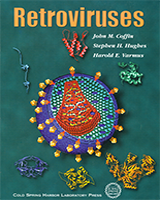NCBI Bookshelf. A service of the National Library of Medicine, National Institutes of Health.
Coffin JM, Hughes SH, Varmus HE, editors. Retroviruses. Cold Spring Harbor (NY): Cold Spring Harbor Laboratory Press; 1997.
The process of retroviral entry into a target cell represents the first step in the viral infection cycle. It is characterized by a complex series of events that are initiated through the binding of the viral surface glycoproteins to specific receptor molecules on the cell's outer membrane. This interaction is thought to trigger a conformational change in the viral glycoprotein, which then mediates fusion of the lipid bilayers of the cell and viral membranes and allows the genetic material of the virus to be introduced into the host-cell cytoplasm.
The envelope glycoprotein complex of retroviruses includes two polypeptides, an external, glycosylated hydrophilic polypeptide (SU) and a membrane-spanning protein (TM), that together form an oligomeric knob or knobbed spike on the surface of the virion. Both polypeptides are encoded by the env gene and are synthesized in the form of a polyprotein precursor that is proteolytically cleaved during its transport to the surface of the cell (see Chapter 7). These proteins are not required for the assembly of enveloped viral particles, but they do have an essential role in the entry process. The SU domain binds to a specific receptor molecule on the target cell. This binding event appears to activate the membrane fusion-inducing potential of the TM protein and, by a process that remains largely undefined, the viral and cell membranes then fuse. The specificity of the SU/receptor interaction defines the host range and tissue tropism of a retrovirus; viral particles lacking envelope glycoproteins are noninfectious, and cells lacking a receptor are nonpermissive for viral entry. Viruses may bind weakly to resistant cells through relatively nonspecific interactions, but, in the absence of a specific receptor molecule, they are unable to initiate the infection process.
The receptors for retroviral entry that have been identified and characterized to date appear to be distinct for the different major viral subgroups, and there is no clear association between their normal cell function and their receptor activity. For human and simian immunodeficiency viruses (HIV and SIV), the CD4 antigen found on T-helper cells, macrophages, and a few other cells is a high-affinity receptor molecule involved in cell-cell recognition (Dalgleish et al. 1984; Klatzmann et al. 1984; Maddon et al. 1986), whereas the receptors for mammalian C-type viruses, including the ecotropic (MLV-E) (Albritton et al. 1989) and amphotropic (MLV-A) (Miller et al. 1994; van Zeijl et al. 1994) murine leukemia viruses, the gibbon ape leukemia virus (GALV) (O'Hara et al. 1990), and feline leukemia virus subgroup B (FeLV-B) (Takeuchi et al. 1992), are three different membrane transporter molecules. For the subgroup A avian sarcoma/ leukosis viruses (ASLV-A), the receptor is a small, plasma-membrane protein of unknown function containing a single copy of a sequence repeated multiple times in the receptor for low-density lipoprotein (Bates et al. 1993; Young et al. 1993). The receptor for the closely related subgroup B ASLV is an unrelated protein bearing resemblance to cytokine receptors (J. Brojatsch et al., unpubl.). For bovine leukemia virus (BLV), a novel receptor protein has been cloned with no similarity to other receptors and no known cell function (Ban et al. 1993).
Binding of the viral glycoprotein to its cognate receptor is not by itself necessarily sufficient to trigger viral entry. Activation of the fusion potential of the TM protein requires a functional association between the receptor and SU. The mechanistic aspects of this process are not yet clearly defined, but they may involve conformational changes within the oligomeric glycoprotein complex, as shown for HIV-1 and SIV (Sattentau and Moore 1993; Sattentau et al. 1993). The molecular events involved in the merging of the apposing lipid bilayers also remain to be defined. Nevertheless, it is likely that several glycoprotein/receptor oligomers must associate within the plane of the membrane for an effective “fusion-pore” to form.
This chapter summarizes our current knowledge of the molecules and processes involved in defining retroviral host range and mediating retroviral entry into a target cell.
- Review [Chemokine receptors and its importance in the replication cycle of human immunodeficiency virus: clinical and therapeutic implications].[Acta Med Port. 2008]Review [Chemokine receptors and its importance in the replication cycle of human immunodeficiency virus: clinical and therapeutic implications].Azevedo-Pereira JM, Santos-Costa Q. Acta Med Port. 2008 Sep-Oct; 21(5):497-504. Epub 2009 Jan 16.
- Activation of membrane fusion by murine leukemia viruses is controlled in cis or in trans by interactions between the receptor-binding domain and a conserved disulfide loop of the carboxy terminus of the surface glycoprotein.[J Virol. 2001]Activation of membrane fusion by murine leukemia viruses is controlled in cis or in trans by interactions between the receptor-binding domain and a conserved disulfide loop of the carboxy terminus of the surface glycoprotein.Lavillette D, Boson B, Russell SJ, Cosset FL. J Virol. 2001 Apr; 75(8):3685-95.
- Role of envelope processing and gp41 membrane spanning domain in the formation of human immunodeficiency virus type 1 (HIV-1) fusion-competent envelope glycoprotein complex.[Virus Res. 2007]Role of envelope processing and gp41 membrane spanning domain in the formation of human immunodeficiency virus type 1 (HIV-1) fusion-competent envelope glycoprotein complex.Welman M, Lemay G, Cohen EA. Virus Res. 2007 Mar; 124(1-2):103-12. Epub 2006 Nov 28.
- Review Cell surface receptors for gammaretroviruses.[Curr Top Microbiol Immunol. 2003]Review Cell surface receptors for gammaretroviruses.Tailor CS, Lavillette D, Marin M, Kabat D. Curr Top Microbiol Immunol. 2003; 281:29-106.
- Activation of a cell entry pathway common to type C mammalian retroviruses by soluble envelope fragments.[J Virol. 2000]Activation of a cell entry pathway common to type C mammalian retroviruses by soluble envelope fragments.Lavillette D, Ruggieri A, Russell SJ, Cosset FL. J Virol. 2000 Jan; 74(1):295-304.
- Viral Entry and Receptors - RetrovirusesViral Entry and Receptors - Retroviruses
Your browsing activity is empty.
Activity recording is turned off.
See more...
